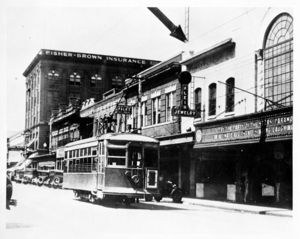Pensacola streetcar system

The Pensacola streetcar (trolley) system was a public transportation system that was operated by various entities between 1884 and 1932.
The streetcar system in Pensacola can be traced to Conrad Kupfrian, a German immigrant who was reportedly inspired by the horsecars he saw in St. Louis on a business trip. He formed a partnership, the Pensacola Streetcar Company, with John Pfeiffer and John Cosgrove. The men raised $50,000 in capital for the project and, on November 15, 1882, convinced the Pensacola City Council to pass an ordinance allowing steel track to be placed in the roadways. The first streetcars, which went operational in 1884, ran from Pensacola Bay north along Palafox Street to Wright Street, then east to the Union Depot, then south along Alcaniz to Gregory and west to DeVilliers Street. A north-south link at DeVilliers went south to Government Street and east again to Palafox. A general fare cost five cents, and cars passed about every ten minutes during high-traffic periods. The company addressed the issue of low ridership after business hours by creating an amusement park destination, called Kupfrian's Park, in the North Hill neighborhood, extending the line west from DeVilliers on La Rua and north on J Street.
Between 1890 and 1891, the Pensacola Streetcar Company was reorganized as the Pensacola Terminal Company under directors J. H. Carter, J. M. Carter and Thomas C. Watson. They created a new line, called the Dummy Line for its use of steam dummy engines, that stretched along Bayshore Drive to Warrington and Woolsey, allowing Navy Yard employees a convenient means to reach the city core. The lines were also extended north to Blount Street and east to East Pensacola Heights. The cost of the extension, which included bridges over Bayou Chico and Bayou Texar, was paid by selling revenue bonds.
An economic downturn affected the streetcar company in 1897. It was reorganized again as the Pensacola Electric Terminal Railway Company, with Captain William H. Northrup as president. William A. Blount's law firm assisted in the transition and introduced northern firm Stone & Webster to help develop the utility. The Pensacola Electric Light & Power Company was also incorporated in 1897, building a coal-powered generator at Baylen and Cedar Streets that provided power to much of the area. Elevated wires were placed over the streets to provide electricity to the trolleys; a double set of tracks were placed in the broad Palafox Street; and a streetcar barn and mechanical shop was built at Gadsden and DeVillier Streets.
In 1906, Boston conglomerate Stone & Webster took over the city's streetcar and electric systems. A 1908 issue of the Stone & Webster Public Service Journal describes the improvements Stone & Webster made to the system, as well as its operations in 1908:
It was in 1906 that the Stone & Webster organization took charge of the traction and electric lighting systems of Pensacola, both of which it has improved. At that time there was a line seven and one-half miles along the shore to Fort Barancas (sic) — is, to the government reservation, where the navy yard is located, and where a good-sized colony exists. This line was electrified for only about a third of the distance, steam being employed over the balance. Today, electricity is the sole power. The city lines of the old company were in inadequate condition, but the situation in this respect has since been much improved. All told, the street railway company now operates 20.39 miles of track. Its equipment consists of 26 passenger cars, with 9 trailers, together with one express car and 11 miscellaneous cars. Power for both the street railway and lighting is supplied from a brick power station, with a capacity for 700 Kw. for lighting and 800 Kw. for traction purposes. The equipment includes a new 300 Kw. Parson's steam turbine, and a new direct connected 500 Kw. railway generator. A brick repair shop, a car barn and several parcels of land in the city are owned by the company. The distributing system of the lighting plant is in excellent condition, having recently been overhauled and thoroughly rebuilt. The electric light franchise is perpetual, having been granted by special act of the legislature. The railway franchise expires in 1933. That part of the line running to the government military reservation is operated under authority granted by the Secretary of War, the grant on the naval reservation being by special act of Congress.
At its peak, a total of 30 trolley cars carried four million passengers per year (1920).[1] Partially covered tracks and barely concealed right-of way are clearly visible on both West Gadsden and DeSoto Street. The trolley was discontinued six years after Pensacola Electric Company's 1932 merger with Gulf Power.
Other images
South Palafox Street, early 1900s
Bayshore line car, circa 1930
South Palafox Street near Plaza Ferdinand VII
The streetcar barn, 1908